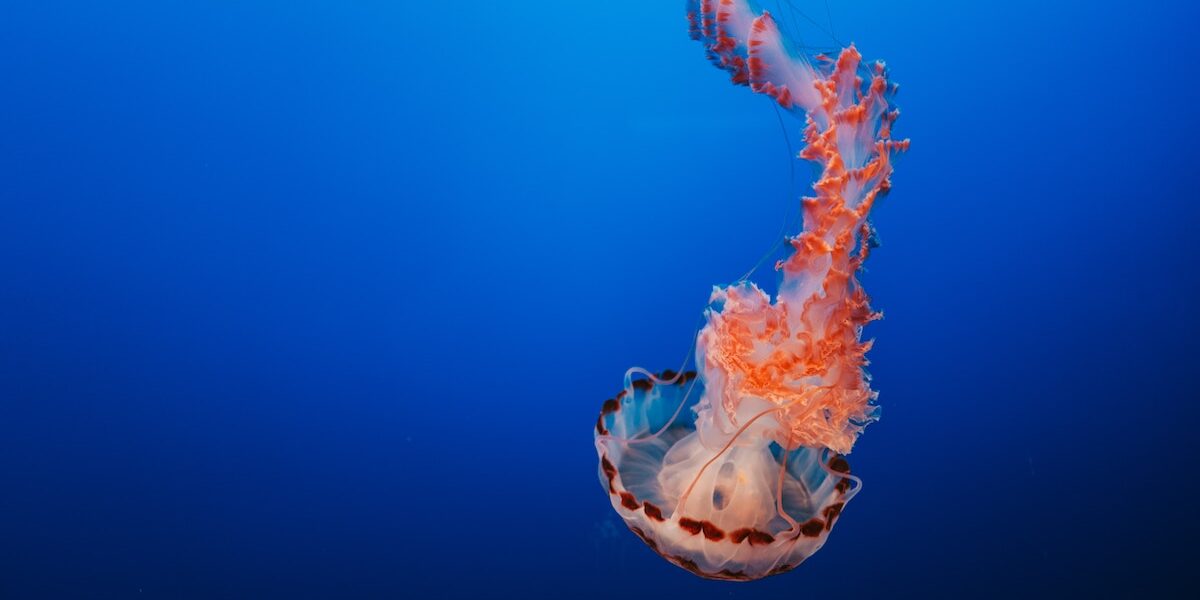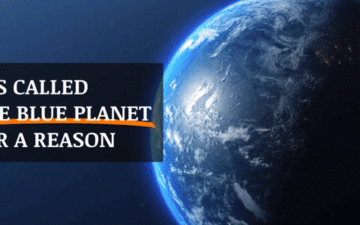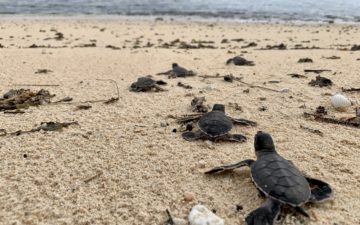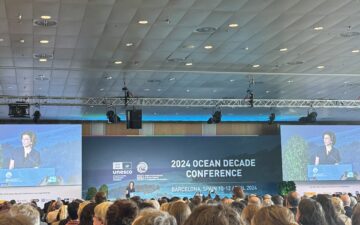The Colorful Blur of October
Part 4: Overlooking the Great Pacific, Looking at the Small Details
by Mark J. Spalding
From Block Island, I headed west across the country to Monterey, California, and from there to the Asilomar Conference Grounds. Asilomar has an enviable setting with great views of the Pacific and long board walks to be had in the protected dunes. The name “Asilomar” is a reference to the Spanish phrase asilo al mar, meaning asylum by the sea, and the buildings were designed and built by famed architect Julia Morgan in the 1920s as a facility for the YWCA. It became part of the park system in the State of California in 1956.
 I was there in my capacity as a senior fellow at the Middlebury Institute for International Studies, Center for the Blue Economy, housed in Monterey. We were gathered for “The Oceans in National Income Accounts: Seeking Consensus on Definitions and Standards,” a summit that included 30 representatives from 10 nations,* to discuss measuring both the ocean economy, and the (new) blue (sustainable) economy in the most fundamental terms: the national accounting classifications for economic activities. The bottom line is that we do not have a common definition for the ocean economy. So, we were there to both parse and harmonize the North American Industry Classification System (NAICS code), together with the associated systems from other nations and regions to frame a system by which the total ocean economy, and the ocean-positive economic activities could be tracked.
I was there in my capacity as a senior fellow at the Middlebury Institute for International Studies, Center for the Blue Economy, housed in Monterey. We were gathered for “The Oceans in National Income Accounts: Seeking Consensus on Definitions and Standards,” a summit that included 30 representatives from 10 nations,* to discuss measuring both the ocean economy, and the (new) blue (sustainable) economy in the most fundamental terms: the national accounting classifications for economic activities. The bottom line is that we do not have a common definition for the ocean economy. So, we were there to both parse and harmonize the North American Industry Classification System (NAICS code), together with the associated systems from other nations and regions to frame a system by which the total ocean economy, and the ocean-positive economic activities could be tracked.
Our goal in focusing on national accounts is to measure our ocean economy and blue sub-sector and be able to present data about those economies. Such data will allow us to monitor change over time and influence policy setting that is important to marine and coastal ecosystem services for the benefit of people and sustainability. We need baseline data on our global ocean economy to measure ecological function as well as market transactions in goods and services, and how they each change over time. Once we have this, we then need to use it to motivate government leaders to take action. We must provide policymakers with useful evidence and a framework, and our national accounts are already credible sources of information. We know that there are many intangibles related to how people value the ocean, so we won’t be able to measure everything. But we should measure as much as we can and distinguish between what is sustainable and what is unsustainable (after agreeing on what that term actually means) because, as Peter Drucker says “what you measure is what you manage.”
 The original SIC system was established by the United States in the late 1930’s. Simply put, industry classification codes are four-digit numerical representations of major businesses and industries. The codes are assigned based on common characteristics shared in the products, services, production and delivery system of a business. The codes can then be grouped into progressively broader industry classifications: industry group, major group, and division. So every industry from fisheries to mining to retail outlets have a classification code, or series of codes, that allows them to be grouped according to broad activities and sub activities. As part of the negotiations leading to the North American Free Trade Agreement in the early 1990s, the United States, Canada, and Mexico agreed to jointly create a replacement for the SIC system called the North American Industrial Classification System (NAICS) which provides more detail an updates the SIC with many new industries.
The original SIC system was established by the United States in the late 1930’s. Simply put, industry classification codes are four-digit numerical representations of major businesses and industries. The codes are assigned based on common characteristics shared in the products, services, production and delivery system of a business. The codes can then be grouped into progressively broader industry classifications: industry group, major group, and division. So every industry from fisheries to mining to retail outlets have a classification code, or series of codes, that allows them to be grouped according to broad activities and sub activities. As part of the negotiations leading to the North American Free Trade Agreement in the early 1990s, the United States, Canada, and Mexico agreed to jointly create a replacement for the SIC system called the North American Industrial Classification System (NAICS) which provides more detail an updates the SIC with many new industries.
We asked each of the 10 countries* just what industries they included in their “ocean economy” in their national accounts (as such a broad activity); and how we might define sustainability in the ocean in order to being to be able to measure a sub activity (or sub-sector) of the ocean economy that was positive for the ocean to be referred to as the blue economy. So why do they matter? If one is trying to quantify how important the role of a specific industry is, or a specific resource, one wants to know which industry codes to collate in order to accurately portray the size or breadth of that industry. Only then can we begin to assign value to intangibles such as resource health, similar to the way trees or other resources play into specific industries such as paper, or lumber or home building.
Defining the ocean economy is not easy, and defining the ocean-positive blue economy is harder. We could cheat and say that all sectors in our national accounts depend on the ocean in some way. In fact, we have long heard (thanks to Dr. Sylvia Earle) that virtually all of the self-regulating mechanisms that keep this planet livable involve the ocean in some way. Thus, we could shift the burden of proof and challenge others to measure those few accounts that are not dependent upon the ocean separately from ours. But, we can’t change the rules of the game that way.
 So, the good news, to start, is that all ten nations have a lot in common in what they list as their ocean economy. In addition, they all seem to be able to easily agree on some additional industry sectors that are part of the ocean economy that not everyone hosts (and thus not everyone lists). There are, however, some industry sectors that are peripheral, indirect or “partially in” the ocean economy (in each nation’s option) [due to data availability, interest etc.]. There are also some emerging sectors (such as seabed mining) that are not entirely on the radar screen yet.
So, the good news, to start, is that all ten nations have a lot in common in what they list as their ocean economy. In addition, they all seem to be able to easily agree on some additional industry sectors that are part of the ocean economy that not everyone hosts (and thus not everyone lists). There are, however, some industry sectors that are peripheral, indirect or “partially in” the ocean economy (in each nation’s option) [due to data availability, interest etc.]. There are also some emerging sectors (such as seabed mining) that are not entirely on the radar screen yet.
The issue is how does measuring the ocean economy relate to sustainability? We know that ocean health issues are critical to our life support. Without a healthy ocean there is no human health. The converse is also true; if we invest in sustainable ocean industries (the blue economy) we will see co-benefits for human health and livelihoods. How are we doing this? We hope for a definition of the ocean economy and the blue economy, and/or consensus on which industries we include, to maximize standardization of what we measure.
In her presentation, Maria Corazon Ebarvia (the project manager for Partnerships in Environmental Management for the Seas of East Asia), provided a wonderful definition of the blue economy, one that is as good as we have seen: we seek a sustainable ocean-based economic model with environmentally sound infrastructure, technologies and practices. One that recognizes that the ocean generates economic values not usually quantified (such as shoreline protection and carbon sequestration); and, measures losses from unsustainable development, as well as measuring external events (storms). All so we can know whether our natural capital is being used sustainably as we pursue economic growth.
The working definition we came up with was as follows:
The blue economy, refers to a sustainable ocean-based economic model and employs environmentally-sound infrastructure, technologies and practices that support sustainable development.
We are not interested in old versus new, we are interested in sustainable versus unsustainable. There are new entrants into the ocean economy that are blue/sustainable, and there are older traditional industries that are adapting/improving. Likewise there are new entrants, such as seabed mining, that very well may be unsustainable.
Our challenge remains that sustainability does not easily coincide with industrial classification codes. For example fishing and fish processing may include small-scale, sustainable actors and large commercial operators whose gear or practices are destructive, wasteful, and clearly unsustainable. From a conservation perspective, we know a lot about different actors, gears etc. but our national account system is not really designed to recognize these nuances.
We want to stop taking for granted ocean and coastal ecosystems that provide us with resources and trade opportunities that greatly benefit human well-being, food security etc. After all, the ocean provides us with the air we breathe. It also provides us with a transportation platform, with food, with medicine, and a myriad other services that cannot always be quantified with four-digit codes. But those codes and other efforts to recognize a healthy blue economy and our dependence on it form one place from which to quantify human activity and its relationship to the ocean. And while we did spend most of our time together indoors, striving to understand different systems in different languages, the Pacific was right there to remind us of our common connection, and our common responsibility.
At the end of the week, we agreed that we need a long-term effort 1) to build a common set of categories, use a common methodology and well defined geographies to measure the market economy of the oceans; and 2) to seek ways to measure natural capital to indicate whether the economic growth is sustainable over the long term (and value ecosystem goods and services), and thus to agree to appropriate methodologies for each context. And, we need to start now on a balance sheet for ocean resources.
This group will be asked in a survey soon to be distributed, to indicate working groups in which they would be willing to participate over the next year, as a precursor to creating the agenda for the 2nd Annual Oceans in National Accounts meeting in China in 2016.
And, we agreed to test pilot this by collaborating on writing a first-ever common report for all countries. The Ocean Foundation is proud to be part of this multi-national effort to address the devil in the details.
* Australia, Canada, China, France, Indonesia, Ireland, Korea, Philippines, Spain and the USA







